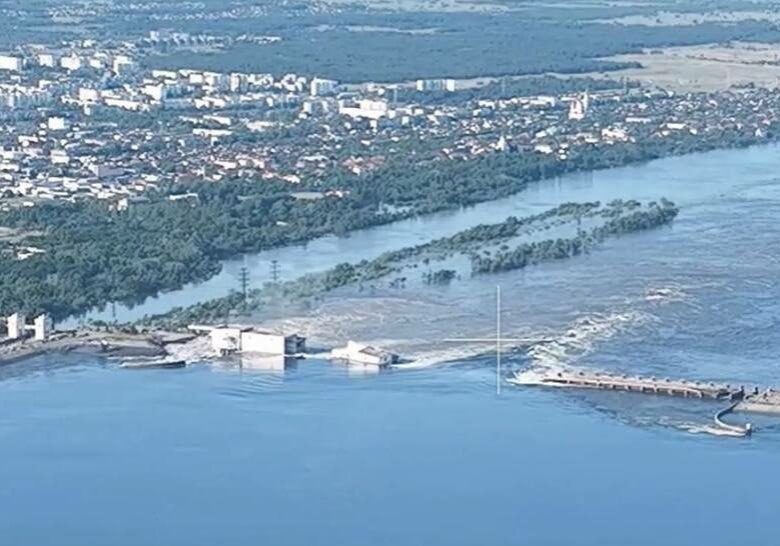Destruction of Nova Kakhovka dam jeopardizes Zaporizhzhia NPP cooling

June 9, 2023 , UPDATE: Ukrainian operators at the Zaporizhzhia nuclear power station (still under Russian military occupation) warn that the water level in the Kakhovka reservoir behind the breached Nova Kakhovka Dam has dropped below 42 feet and that the nuclear reactor’s cooling water pumping station is no longer capable of pumping water up to replenish cooling water levels going into the six shutdown reactors from the reserve cooling water canal and storage pond system. IAEA is disputing this reporting of the reactor operator’s alert and maintains that there is no imminent threat of fuel damage given that current cooling water reserves onsite in cooling channels and ponds are adequate for several more months.
The military clash between Ukraine and Russia forces has caused a major breach of the Russian-controlled Nova Kakhovka hydroelectric dam on the Dnieper River and severe flooding downstream of the Russian-controlled Zaporizhzhia nuclear power plant (ZNPP) in southern Ukraine. As many as 100 settlements are threatened by severe flooding prompting the evacuation of thousands of Ukrainians. The dam collapsed at the onset of the Ukrainian military counteroffensive. The Kakhovka Reservoir is flowing through the breach and flooding much of the conflict zone’s southern frontline. Each side has accused the other of sabotaging the large dam by explosives to initiate the dam breach and flooding of a strategic battle zone. The hydroelectric plant is no longer operational.
The International Atomic Energy Agency’s (IAEA) Director General Rafael Grossi issued a status report (see June 9th UPDATE) on the impact of the dam destruction on the ZNPP station. The breach in the dam has significantly dropped in the level of water in the reservoir which is the main source of cooling water to the ZNPP reactors. While the six reactors have been shut down from power production for several months their reactor fuel cores remain extremely hot.
The constant circulation of cooling water through all six reactors is still essential for “residual heat removal” as well as residual heat removal from the site’s multiple “spent fuel” pools which still generate heat from the large volume of extremely radioactive and thermally hot high-level nuclear waste (irradiated fuel assemblies) which are submerged for cooling and shielding. Cooling water is also essential to reliably maintain operability of the power station’s backup power operation of emergency diesel generators necessary for reactor safety systems in the event of a loss of offsite power from the electrical grid which is vulnerable to attack and cross fire.
At publication time, the IAEA reports that there is “no immediate risk” of the loss of cooling to the six shutdown reactors, the irradiated fuel storage ponds and cooling water supply to multiple emergency back-up diesel generators. Offsite electrical power from the grid is still providing 100% of the power to the site’s reactor safety systems.
As of the morning of June 7th, water in the Kakhovka reservoir was roughly 54 feet deep and the level falling at approximately 2 inches per hour. If the water level drops to below 41.7 feet, the main cooling system’s current design will no longer be able to pump up water from the reservoir into cooling channels and the nuclear power station. However, the pumping is expected to continue for several more days. In the meantime, station operators are endeavoring to pump as much water into the cooling channels and additional onsite cooling ponds in hopes of extending cooling operations for several months.
The report warns, “Absence of cooling water in the essential cooling water systems for an extended period of time would cause fuel melt and inoperability of the emergency diesel generators.” The continued military conflict however could also cause more damage to the reactors’ systems, structures and components as well as their common cooling channel system.
The IAEA is closely monitoring the situation.
In times of national emergency, natural disaster and climate adversity, nuclear power is increasingly more a liability than an asset.
Support Beyond Nuclear
Help to ensure a safer, greener and more just world for all

